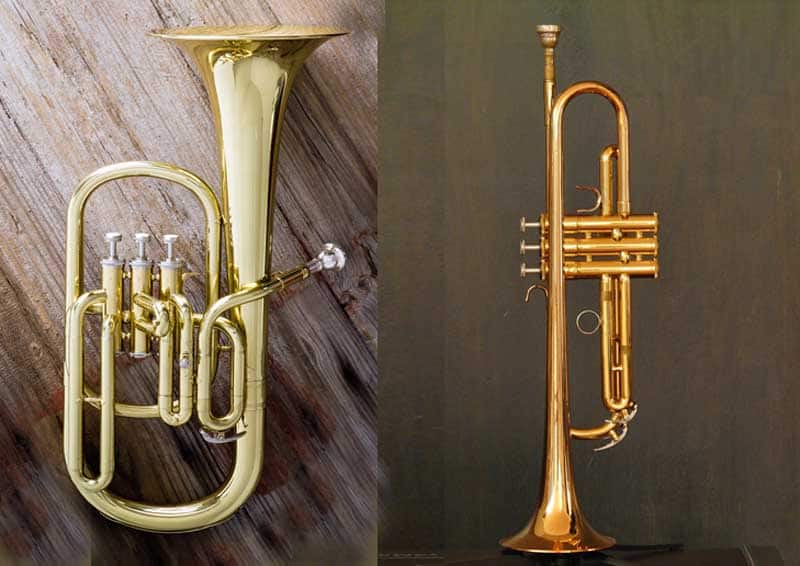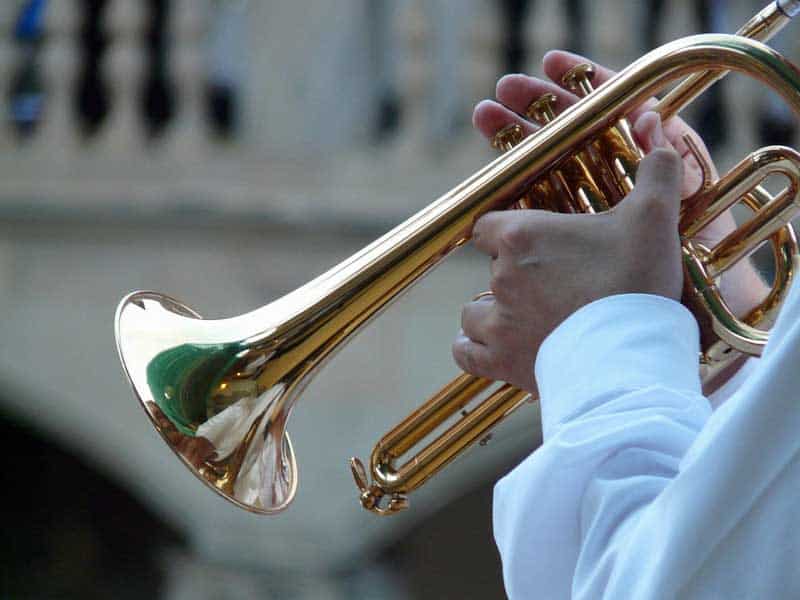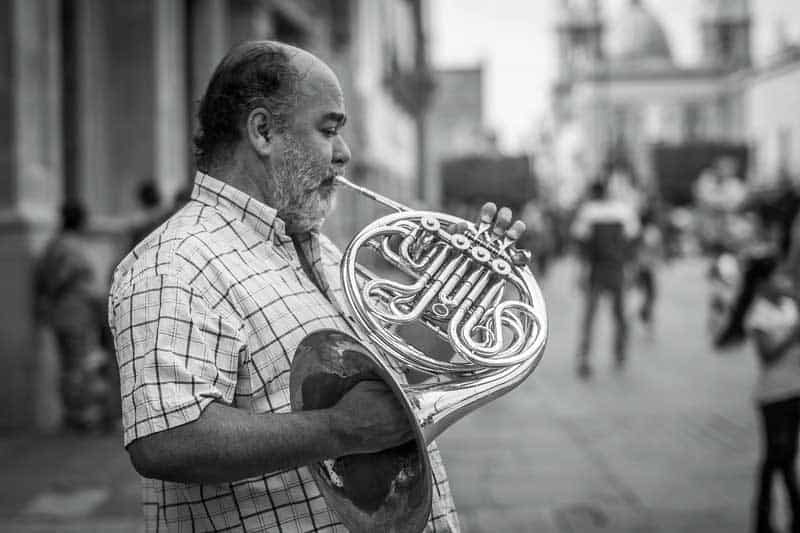A big part of the brass instrument family can be categorized as horns, but not all of them.
Let’s look at the differences between trumpets and horns.
The Reason Why Trumpets Are Not Horns
The trumpet is built around a tube with a constant diameter (cylindrical bore) whereas horns are constructed around a tube that gets thicker and thicker (conical bore). This gives trumpets a brighter sound and horns a darker sound.
Table of Contents

When you take a good look at the Euphonium horn (above to the left) you will notice that the tube starts to get thicker after the first few bends.
The trumpet, however, has a constant thickness of the main tube throughout the instrument, and only after the last bend (toward the bell) does the tube increase in thickness.
This makes a big difference to the “timbre” which is the perceived color of a sound.
Two sounds can have the same frequency but they can sound completely different. Like the difference of a piano and a trumpet.
The same goes for trumpets and horns.
How Else Are Trumpets Different from Horns?
Let’s look at a few other differences between trumpets and horns that are relevant when we want to distinguish the two.
Trumpets Require More Embouchure
The high-pitched tonal register of a trumpet require the trumpet player to have a good strong embouchure.
The embouchure determines the tonal range and endurance of the player.
If you don’t practice for weeks or months you will more quickly lose some upper tonal range on the trumpet because the embouchure of the lips is weakened.
On bigger horns (such as euphonium, baritone, and tubas) you can typically maintain a good tonal range and endurance for longer as the bigger mouthpiece requires less tension from the lip muscles during play.
Horns are More Expensive
The construction of a horn requires more brass material. This also means that the instrument is more expensive to produce.
The most expensive brass instrument is typically the French horns and the tubas. The tuba is the biggest brass instrument and the French horn is also expensive to produce due to the unique circular construction of the pipes.
You can see a picture of the beautiful French horn further down the article. Notice how the player positions the right hand inside the bell of the horn.
This also makes the color of the tone darker and more like a horn.
French horns and tubas can cost well over $15,000 while professional trumpets rarely cost more than $6,000 – $8,000.
Trumpets are Much Easier to Carry With you
Another little detail worth mentioning when comparing trumpet and horns is the weight and size.
It’s just a lot easier to bring a trumpet to class than an euphonium or a tuba.
You need to consider the weight of the instrument as well as the volume. A trumpet will weigh around 2-3 lb (1 – 1.4 kilograms) while a tuba can weigh as much as 35 lb (16 kilograms).
Check this article that compares baritone horns and trumpets.
Are Trumpets or Horns Easier to Play?
It takes more practice to learn how to produce a good stable and crack-free sound on a trumpet. This is because the mouthpiece is smaller so a smaller part of the lips will produce the buzzing sound. It’s easier to make the lips create the buzzing sound inside a horn mouthpiece.
But really, that’s only relevant for the first couple of months as you learn how to play the instrument.
You should probably think more about your personality when deciding between a trumpet or a horn. Trumpeters tend to play the main melody and get more solos than horns.
If you like to stand in the front and have everyone look at you, the trumpet is a good choice.
However, if you don’t like attention you can more easily hide in the “crowd” of players behind a horn.
What’s the Definition of a Horn?
The family of horn instruments is defined by 1/3 of the tube being cylindrical and the last 2/3 being conical. This means that only a smaller part of the pipe has a constant diameter while the rest of the pipe gradually increases in thickness out toward the bell.
This might not sound like a big deal but it makes a big difference when it comes to the timbre of the sound.
The sound from the horn gets the characteristic deep color from the construction of the pipe and the bigger bell.
Which Instruments are Considered Horns?
The follow brass instruments are considered horns:
- Tubas
- Trombones
- Baritones
- Euphoniums
- French horns
- Flugelhorns

The flugelhorn is often played by trumpeters when they want a darker and more horn-like sound. You will often see trumpeters switch between trumpets, flugelhorns, and Eb cornets.
The trombone is actually an outlier here as it actually has the same construction as a trumpet when it comes to the constant thickness of the pipe.
The trombone does not have valves. Instead, it has a retractable pipe that changes the total length of the pipe in order to enable it to play the different notes.
What’s the Definition of a Trumpet?
On trumpets, 2/3 of the pipe will have a constant thickness and only the last 1/3 of the pipe will have an increased thickness of the pipe. This gives the trumpet a brighter sound that’s easy to distinguish from the sounds horns make.
Again, the difference here between trumpets and horns is defined by only 1/3 of the tube on the instrument.
A trumpet also has a mouthpiece that looks different from mouthpieces for horns. You can check this article about different sizes of mouthpieces for trumpets.
Which Instruments are Considered Trumpets?
These instruments are considered trumpets:
- Regular trumpets (Bb or C key)
- Piccolo trumpets (Eb or Bb)
- Fanfare/Herald trumpets (Bb)
- Pocket trumpets (Bb)
- Slide trumpets (Bb)
The cornet is also very similar to the trumpet and many people cannot distinguish the sound of the two.
The main difference between trumpets and cornets is the construction of the pipe. The cornet has more 180 degree curves which makes it more compact and smaller.
Can I Call a Trumpet a Horn?
Many people refer to trumpets as horns but that’s not correct. A trumpet is not a horn because the thickness of the pipe is constant for the first 2/3 of the total length. However, it’s only a minor difference and both trumpets and horns belong to the brass family of instruments.
You will probably not get in trouble for referring to a trumpet as a horn, unless you’re talking to a professional trumpeter or horn player.
In fact, even Wikipedia refers to the trumpet as a horn in several articles.
What Is a Trumpet Classified As?
The trumpet is classified as a brass instrument along with the whole family of horns. All brass instruments are made of brass, silver, or gold, and they are built around a tube with a mouthpiece. The sound comes from a buzzing sound made by the lips of the player.
The best way to categorize trumpets and horns together is to refer to them as brass instruments.
They are called “brass instruments” even though we find several brass instruments that are not made of brass. They can also be made from silver and gold. However, most brass instruments are made entirely of brass.
Brass is what we call an “alloy”.
And alloy is basically what you get when you mix different types of metallic elements. The brass alloy consists of copper and zinc.
What Is a Tiny Trumpet Called?
There are two types of tiny trumpets. The piccolo trumpet is a trumpet tuned an octave above regular trumpets and a pocket trumpet is just a more compact trumpet as the main tube has more turns. The tiny piccolo trumpet has 4 valves to make it easier to play lower notes in tune.
The most-used tiny trumpets are the piccolo trumpets. They are used in most orchestras and you can quickly spot them as they are really small.
You see them sitting between the trumpeters and the trombone players in a classical orchestra.
The piccolo trumpet will be playing an octave above the trumpet but we also have an Eb cornet that’s playing in a key between a regular trumpet and a piccolo trumpet.
Pocket trumpets, however, are rarely used in a basic orchestras or brass bands. They are more made for fun, practice, and travel.
The Eb cornet is more like a regular trumpet, just smaller.
What Is the Difference Between a Trumpet and a French Horn
The tubes used for French horns are only a little bit thicker than the trumpet tubes and therefore it has a bright sound as well. However, the french horn is harder to play due to the very small mouthpiece and the higher tonal range.

I actually have a full article explaining this where you can also learn why the French horn is harder to learn than the trumpet.
When you look at the construction of the French horn you will notice this. This is called a “cylindrical bore” while a regular horn will have a “conical bore”.
You get an extra octave of range with the French horn compared to the standard trumpet.
Even though the French horn also has 2/3 of the tube being cylindrical (constant diameter) the tone of the sound is darker because the bell is much bigger than the bell on the trumpet.
Other than that, the player will position the right hand inside the bell in order to hold the horn. This also contributes to a darker and more horn-like sound to the French horn.
Sources
https://www.yamaha.com/en/musical_instrument_guide/horn/selection/
